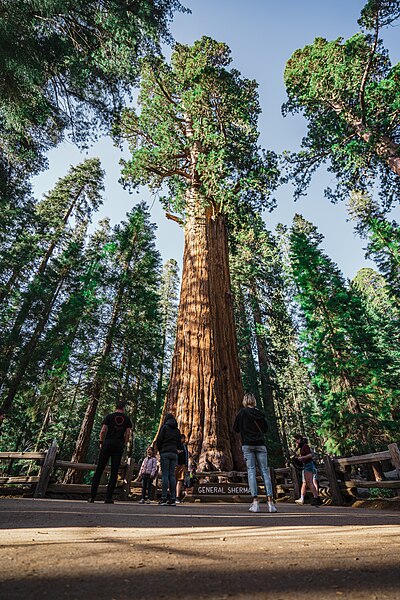General Sherman Tree – The Largest Living Organism on Earth

Nestled within Sequoia National Park in California, the General Sherman Tree stands as one of the most awe-inspiring natural wonders of our planet. Towering over the landscape at a remarkable height and with a massive girth, this giant sequoia (Sequoiadendron giganteum) holds the title of the largest living organism by volume. In this blog, we’ll take a closer look at the history, grandeur, and significance of this majestic tree.
What Makes the General Sherman Tree So Special?
The General Sherman Tree isn’t just tall — it is absolutely massive. Standing at an incredible height of 275 feet (83.8 meters), it’s the largest tree on Earth by volume, estimated at 52,508 cubic feet (1,487 cubic meters). While it’s not the tallest tree in the world (that title belongs to Hyperion, a coast redwood in Northern California), it is the most voluminous, surpassing any other living organism when it comes to sheer size.
The tree’s trunk has a circumference of 102.6 feet (31.3 meters) at ground level and is covered with thick, reddish-brown bark. Some of the largest branches are wider than most adult humans are tall! The size and scale of the General Sherman Tree are hard to fully grasp until you see it in person — its towering height and immense volume are truly humbling.
A Long History of Growth
The General Sherman Tree is estimated to be around 2,200 years old, making it a true survivor of ancient history. It began growing around the time of the rise of the Roman Empire. Through centuries of changes in the Earth’s climate and ecosystem, this tree has withstood fires, droughts, and the passage of time, continuing to grow to its current size.
Despite the natural challenges it has faced over the centuries, General Sherman has thrived. Its resilience can be attributed to the natural properties of the giant sequoia species, which is uniquely adapted to survive fires. Their thick, fire-resistant bark helps protect them from the intense heat of wildfires, allowing them to live for millennia.
A Landmark of Sequoia National Park
Located in the Giant Forest area of Sequoia National Park, the General Sherman Tree is a central attraction for visitors. The tree itself is easily accessible through a paved path and a series of stairs, leading to a vantage point where visitors can truly appreciate its enormous size. There’s also an informative sign nearby that educates visitors about the tree’s significance.
Sequoia National Park, established in 1890, was created to protect these magnificent trees and the surrounding wilderness. The park is home to five of the ten largest trees in the world, including General Sherman. The Giant Forest, where General Sherman stands, is an incredible place to explore on foot, offering visitors a chance to connect with some of the largest living beings on Earth.
The Importance of Conservation
While the General Sherman Tree is thriving today, it’s essential to recognize the ongoing efforts to preserve it and its surrounding forest. Giant sequoias are a species that face significant environmental challenges, from climate change to human encroachment. Protecting areas like Sequoia National Park is crucial not only for preserving the General Sherman Tree but also for safeguarding the diverse ecosystem that thrives within the park.
The trees play a pivotal role in maintaining the health of the forest, serving as habitats for numerous species of wildlife and contributing to the park’s overall biodiversity. As visitors, it’s important to respect these natural wonders and follow the guidelines set by park authorities to ensure their preservation for future generations.
Fun Facts About General Sherman
It’s not the tallest: While General Sherman is one of the tallest trees in the world, it’s actually shorter than some coastal redwoods, which can grow to heights over 370 feet.
Growth over time: General Sherman adds an average of 60 cubic feet of wood to its trunk every year, which means it grows in volume more than most people can comprehend.
Incredible bark: The tree’s bark, which is up to 3 feet (1 meter) thick in some areas, is resistant to both pests and fire, helping it survive many of the challenges it faces.
Name origin: The tree is named after General William Tecumseh Sherman, a famous Civil War general. It was named in the late 19th century, and while the tree is not the largest by height, it stands as a living monument to both history and nature.
References:
https://en.wikipedia.org/wiki/General_Sherman_(tree)










